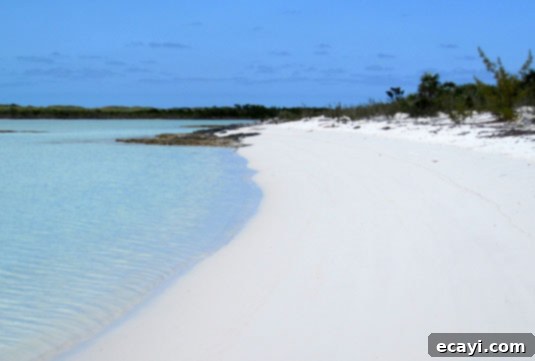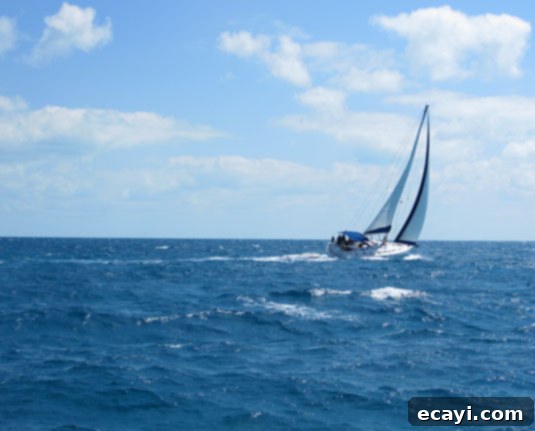Seamless Galley Life: Mastering Meal Planning & Cooking on a Sailboat in the Bahamas
Embarking on a sailing adventure offers unparalleled freedom and breathtaking views, but the galley often presents a unique culinary challenge. Discover essential tips and a sample menu to flawlessly plan a week of delicious meals while cruising the open waters.
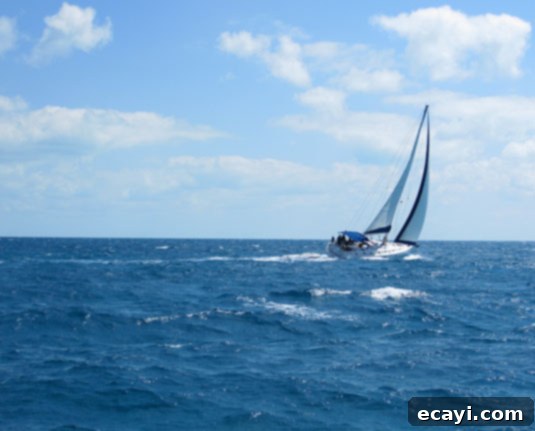
Returning from a week of sailing through the stunning Bahamian islands, I find myself enveloped in a profound sense of peace and tranquility, despite a mountain of deadlines and emails awaiting my attention. This newfound calm is undeniably a direct result of our recent adventure: an unforgettable week-long cruise through the exotic Exumas with my partner, E, and three dear friends. Two of our companions, seasoned sailors with their own vessel in Quebec, provided an incredible opportunity to join them on their beautiful, private 36-foot sailboat. Our journey took us across crystal-clear waters shimmering in unbelievable shades of blue, to explore secluded beaches, and to marvel at vibrant marine life through our snorkeling masks. And, perhaps surprisingly, it also involved crafting delightful meals in our remarkably compact sailboat kitchen.
From the outset, even before our grand voyage commenced, I eagerly volunteered to take on the role of head chef for the week. I saw it as an exciting challenge and was genuinely curious to uncover the specific limitations and critical factors involved in preparing food out at sea. Moreover, the necessity of meticulous meal pre-planning was paramount. Our sole opportunity to stock up on groceries would be prior to our departure from the bustling Nassau marina. This meant that a precise, itemized grocery list was not just helpful, but absolutely essential. Furthermore, we compiled a separate list of non-perishable items we could conveniently bring from home. To ensure everyone was on board and to solicit feedback, I meticulously prepared a detailed spreadsheet of our proposed menu, sharing it with my friends well in advance. This collaborative approach allowed everyone to contribute their thoughts and flag any potential omissions, setting the stage for a well-provisioned and delicious week.
Our compact yet functional galley for the week, aboard the 36-foot sailboat “Congo,” proved that gourmet meals are possible even in a small space.
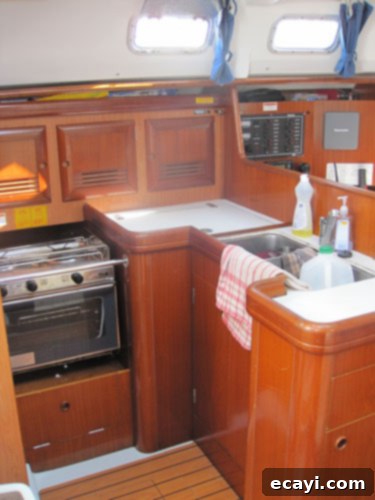
My pre-trip research involved extensive searching for practical advice on boat cooking. The tips I gathered proved invaluable in meticulously planning a week’s worth of diverse and satisfying meals for our crew of five enthusiastic food-lovers. These insights transformed what could have been a logistical nightmare into an enjoyable culinary experience.
Essential Galley Tips: Mastering the Art of Cooking on a Sailboat
Preparing meals on a boat presents unique considerations that differ significantly from cooking in a traditional home kitchen. Here are some indispensable tips to ensure your sailing trip is filled with delicious, hassle-free meals:
- Anticipate Increased Appetites at Sea: The ocean environment, with its constant motion and the physical demands of sailing, tends to make people hungrier than they would be on land. Unlike sitting at a desk where movement is minimal, on a boat, your body is continuously engaging muscles to maintain balance, manage ropes, or steer the helm. This increased physical activity burns more calories. To prevent overtired and “hangry” crew members by dinnertime, always have a supply of healthy, energy-boosting snacks readily available throughout the day. Think fresh fruit, nuts, energy bars, and crackers with cheese or hummus.
- Prioritize Dietary Needs and Preferences Pre-Departure: It is absolutely crucial to ascertain all your fellow travelers’ tastes, allergies, and dietary restrictions before you leave the marina. An allergic reaction out at sea, far from medical facilities, is a serious concern. Furthermore, the limited space in a sailboat’s galley means you simply won’t have the luxury of preparing separate alternative dishes for picky eaters. Clear communication beforehand will save immense stress and ensure everyone can safely enjoy the planned meals.
- Align Meal Plans with Onboard Equipment: This tip might seem obvious, but it’s frequently overlooked. Before finalizing your menu, obtain a precise, exhaustive list of every piece of kitchen equipment available on the boat. Do you have an oven, a grill, a microwave, or just a stovetop? Many sailboats, especially smaller ones, lack an oven. Relying solely on a barbecue might also be risky if it breaks down or if weather conditions prevent its use. Diversify your cooking methods and have backup plans. Don’t assume standard appliances like a coffee maker or toaster will be present, as power restrictions often preclude them.
- Create an Exhaustively Detailed Grocery List: Generic shopping lists are a recipe for disaster on a boat trip. Instead of merely writing “onions,” specify “3 large onions” or “1 kg potatoes.” This meticulous approach prevents unnecessary waste, ensures you have sufficient quantities of every ingredient, and significantly streamlines the provisioning process at the grocery store. You won’t be stopping to guess quantities, which saves precious time before departure.
- Bring Your Essential Kitchen Tools: Rental boats are typically equipped with a bare minimum of kitchen tools, and their quality is often subpar. Knives, in particular, are notorious for being dull and multi-purpose (used for everything from bread to rope). Invest in bringing your favorite, sharp chef’s knife, a small and easily cleaned cutting board, a reliable corkscrew, and any other small, indispensable gadget you rely on for meal preparation. These few items will dramatically enhance your efficiency and enjoyment in the galley.
- Provision Smartly from Home: Maximize your luggage allowance by bringing as many non-perishable items as possible from home. This includes spices (which can be expensive and hard to find abroad), vacuum-packed meats, canned goods, and shelf-stable snacks. Not only will you ensure access to familiar brands and specific ingredients, but you’ll also likely find these items are significantly cheaper at your local grocery store compared to tourist-heavy sailing destinations. This strategy frees up your budget for fresh local produce and proteins.
- Plan for Beverages, Including Alcohol – But Judiciously: Don’t forget to account for drinks, including alcoholic options. However, exercise caution with alcohol consumption at sea. Many sailors report that the effects of alcohol are amplified on a boat, so you might not require as much as you would typically drink on land. Furthermore, storage space is extremely limited. Bottles of wine and beer consume considerable space. Opt for canned beer, which is easily stored, stackable, and unbreakable. For spirits, choose compact bottles of liquor like rum or vodka over bulky wine bottles, though a minimum amount of wine for special occasions is understandable.
- Designate a Single Food Manager: While everyone can and should assist with meal preparation, serving, and cleanup, assigning one person primary responsibility for food management is incredibly beneficial. Fitting all groceries into the limited fridge space and various hidden storage compartments on a boat is a puzzle. Having one person remember where everything is stored vastly streamlines the process. This designated individual also oversees ingredient freshness, advising when items need to be consumed or discarded, preventing widespread illness among the crew.
- Acknowledge and Respect Limited Storage Space: This cannot be overstated, especially regarding refrigeration. Most sailboats have small fridges, often with no dedicated freezer compartment or only a tiny one. Prioritize liquids that are shelf-stable at room temperature, such as Tetra-packed pasteurized juices and UHT (ultra-high temperature processed) milk. Plan meals that require minimal refrigeration for later in the trip, or rely on ingredients that keep well in cool, dry places.
- Strategically Balance Meals Based on Perishability: Effective meal planning on a boat involves a careful balance between perishable and non-perishable ingredients. Consume highly perishable foods, like fresh meat, poultry, and certain vegetables, early in the trip. Reserve meals based on canned goods, dried foods, and ingredients with a longer shelf life (e.g., pasta, rice, root vegetables) for the latter part of your journey. If fresh meat is purchased, buying it frozen can extend its usability; it will gradually defrost in the fridge, allowing for longer safe storage. Handle eggs with extreme care, as their freshness can degrade quickly in tropical climates.
- Prepare Lunches in Advance for Smooth Sailing: Attempting to cook a full meal while the boat is underway, especially in choppy seas, is often impractical and can lead to seasickness. Even on a calm day, the constant motion of the boat makes cooking challenging. Plan for lunches that can be prepared in the morning while anchored. Sandwiches, wraps, and pre-made salads are ideal. Ensure these ready-to-eat meals are easily accessible in the fridge so that any crew member can grab lunch if the designated cook is feeling unwell or busy.
- Understand Local Garbage Disposal Regulations: Before setting sail, inquire thoroughly about local garbage disposal restrictions and allowances. We initially assumed we would have to store all our trash until the end of the trip, leading to unpleasant odors. We later discovered that in the Bahamas, all organic waste – anything that would typically go into a compost bin – could safely and responsibly be disposed of in the sea. Knowing this beforehand would have saved us considerable discomfort and allowed for better waste management. Always verify local environmental guidelines for responsible waste disposal.
The sheer volume of groceries we had to meticulously organize and store aboard the sailboat was initially daunting, but with a bit of ingenuity and careful planning, every item found its designated place.
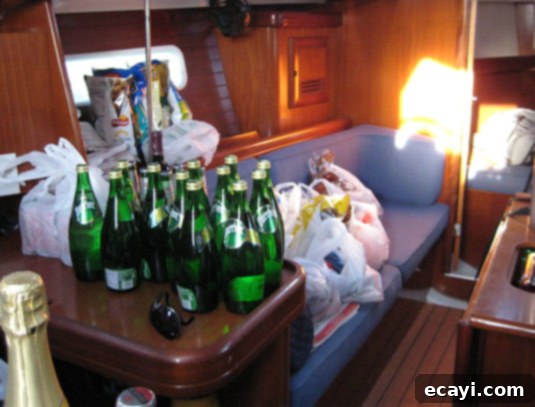
Sailboats are remarkably efficient in utilizing every available inch for storage. We discovered water gallons cleverly stowed under seats, wine bottles integrated into the table design, and beer cans neatly tucked away beneath floor panels.
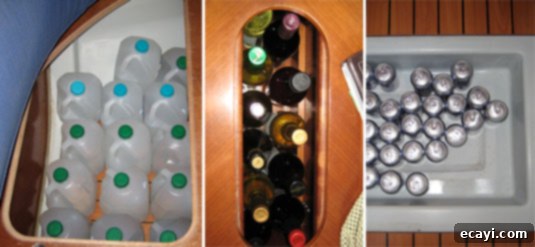
A simple headlamp proved to be an unexpectedly indispensable gadget, providing crucial illumination to monitor pizzas baking in the oven, which lacked an interior light.
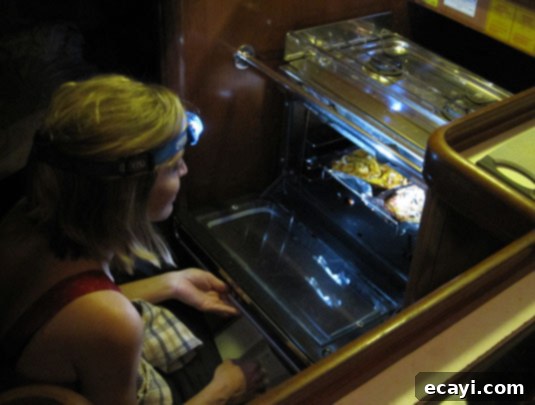
Regardless of your chosen destination, cooking at sea is an incredibly rewarding and memorable experience. I genuinely cherished every moment in what was undoubtedly the smallest kitchen I have ever worked in. With a little ingenuity, creativity, and careful planning, I was able to prepare meals that were just as satisfying and delicious as those I would make at home. I even managed to bake chocolate cupcakes for E’s birthday, proving that no culinary delight is truly out of reach on a sailboat! My fantastic crew, who not only loved every dish but also served as enthusiastic and diligent helpers, made the experience even more enjoyable. Not once did I have to worry about cleaning up after meals – truly a dream scenario! We managed our provisions efficiently, avoided waste, and never once went hungry. This trip was a unique blend of adventure and gastronomy, and I will forever treasure the opportunity I had to cook on this beautiful sailboat.
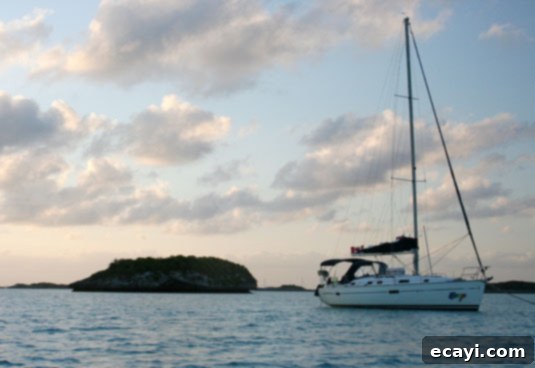
For those curious about the specifics of our onboard culinary journey, I’ve included our detailed sample menu below. You’ll see that we absolutely did not sacrifice taste or variety for practicality!
A Week’s Sample Menu for Sailing the Exumas
Breakfast
- Freshly toasted bread (prepared in the boat’s oven)
- Assorted jams, creamy peanut butter, and rich cream cheese spreads
- Variety of cereals and nutritious muesli
- Homemade blueberry, banana, and walnut muffins (baked fresh on the boat)
- Individual servings of yogurt
- Fresh bananas and oranges for a healthy start
Lunch
- Hearty ham, turkey, and cheese sandwiches (served twice during the week)
- Flavorful tuna salad wraps, easy to prepare and eat on the go
- Smoked salmon and cream cheese bagels for a touch of indulgence
- Delicious oven-baked ham and vegetable frittata, perfect for using up fresh ingredients
- Loaded oven-baked nachos with all the fixings: leftover BBQ chicken from fajitas, olives, fresh green onions, zesty salsa, crisp bell peppers, spicy jalapeño peppers, and melted cheese
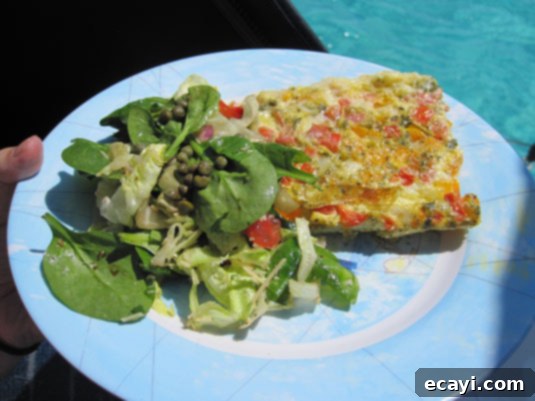
Dinner
- Classic burgers, grilled on the barbecue for that authentic outdoor flavor
- Marinated pork and beef kebabs, served alongside fluffy brown rice and a medley of sautéed vegetables
- Chicken fajitas with sizzling BBQ chicken, perfectly sautéed bell peppers and onions, accompanied by creamy guacamole, fresh coriander, crisp lettuce, vibrant salsa, and shredded cheese
- Delicate fish “En Papillote” (cooked in parchment paper) baked on the barbecue, served with tender broccoli and rice flavored with chickpeas, green onions, coriander, and aromatic Indian spices
- Pizzas, two creative ways: classic tomato, olives, ham & parmesan cheese, and savory BBQ chicken, barbecue sauce, red onion & cheddar cheese (all made on convenient oval flatbreads)
- Pasta dish featuring a robust sauce of tomato, tuna, olives, capers, and a generous sprinkle of parmesan cheese
These delicious nachos perfectly complemented a refreshing Kalik, the popular beer of the Bahamas, making for an ideal happy-hour snack.
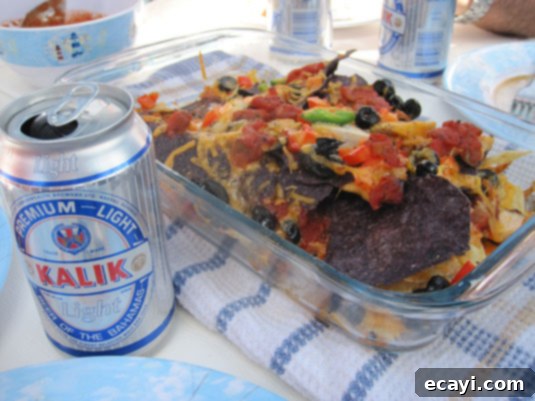
Snacks
- Crunchy tortilla chips and zesty salsa
- Assorted nuts and sweet dried cranberries for an energy boost
- Sliced apples paired with sharp cheddar cheese
- Refreshing cantaloupe and juicy watermelon slices
- Creamy hummus with crisp chips and a selection of chopped fresh vegetables
- An assortment of convenient granola bars
Sweets
- Fudgy brownies (prepared from a mix, enhanced with chopped walnuts and extra chocolate chips)
- Moist chocolate cupcakes (from a mix, made special with added chocolate chips and rich chocolate frosting)
- Decadent dark chocolate bars for a simple, satisfying treat
An elegant happy-hour setup featured chilled white wine, savory black pepper dry sausage, briny green olives, and delicate smoked salmon canapés, beautifully captured by François Carpentier.
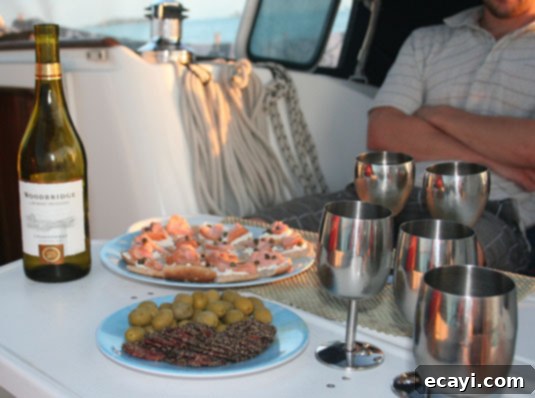
Warderick Wells Cay boasts what many consider the most beautiful beach in the world, a truly idyllic spot to relax and enjoy the Bahamian splendor.
